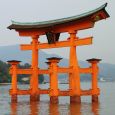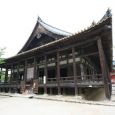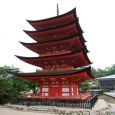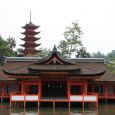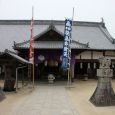Miyajima
Advertisement
By ferry
Miyajima can be reached by sea from Hiroshima. The main ferry terminal on the mainland is Miyajimaguchi , which can be reached from JR Hiroshima station either by train or tram line #2 . The tram line also passes by the Peace Memorial Park.
From Miyajimaguchi, JR ferries and Matsudai ferries run to Miyajima up to 10 times per hour. The trip takes 10 minutes and costs ¥170 each way; Japan Rail Pass holders can use the JR ferry for free. The last ferry returns to the mainland at 10:40PM. Most tour groups are gone after 5PM, so you'll have a different experience on the island if you wait them out.
No bridges connect Miyajima to the mainland. Some ferries will carry automobiles and motorcycles, but parking on the island is expensive and difficult to find, unless arranged in advance with a hotel on the island, and most of the sights can't be reached by car. Quite a few of the hotels are willing to pick guests up from the pier with advance notice, though.
Itsukushima Shrine
The Itsukushima Shrine extends out over the water so that at high tide it seems to be floating on the sea. It consists of the Main Shrine and many subsidiary shrines and buildings all connected by wide corridors and galleries. Itsukushima Shrine has been designated as a National Treasure.
Miyajima Torii
In the water near the Itsukushima Shrine stands the world renowned Torii, Otorii, one of the largest in Japan. The view through the Torii framing Mount Misen in the background is one of the most photographed scenes in Japan.
Senjokaku Shrine - The Hall of a Thousand Tatami Mats
In 1587AD Hideyoshi Toyotomi, the warlord who unified Japan during this era, ordered the establishment of Senjokaku Shrine as a place where sutra-chanting would be held in honor of war casualties. While it is the biggest building in Miyajima, it has never been finished with its construction halting on Hideyoshi Toyotomi's death. Senjokaku is derived from its planned floor space, which is equal to the area of 857 tatami mats.
Goju-no-to
Goju-no-to is a vermilion red Five-Storied Pagoda built in 1407AD shows a splendid structural beauty which skilfully combines the beauty of Japanese and Chinese architectural styles. Goju-no-to is 27.6 metres high. Goju-no-to is located next to Senjokaku Shrine.
Daiganji Temple
Located next to Itsukushima Shrine, Daiganji Temple is an ancient Shingon Buddhist temple with strong ties to Shinto shrines. It used to be in full charge of the repair and construction of temples and shrines including Itsukushima Shrine. Daiganji Temple is dedicated to Benzaiten, the goddess of eloquence, music, and wealth, and enshrines one of the three most famous Benzaiten statues in Japan in addition to many other valuable Buddhist statues.
Daishoin Temple
Daishoin Temple is an ancient Shingon Buddhist temple built at the foot of the sacred Mt Misen. During the time of fusion period of Shintoism and Buddhism, this distinguished temple governed all priests in Miyajima and was in charge of religious ceremonies of Itsukushima Shrine. Its green, plant-filled precincts command a fine view and are very photogenic with its many decorated Buddhist statues.
Tahoto Pagoda
Built by the priest Shukan in 1523, Tahoto is a pagoda with a height of 15.6 meters. Although constructed mainly in Japanese style, parts of the structure have Indian and Chinese architectural features. It presents the unique combination of a square shape on the lower level and a round shape on the upper level. During cherry blossom seasons, it shows a breath-taking scenery under spot lights.
Kiyomori Shrine
Kiyomori Shrine is built right down on the waters edge on a small island formed by the river on one side and the sea on the other. Kiyomori Shrine was built in 1954 to eulogize the achievement of the famous General Taira-no-kiyomori
Homotsukan (Treasure Hall)
Homotsukan was built to store the numerous treasures and documents of the Itsukushima Shrine in 1934. There are about 4500 items displayed including Heike Clan's Buddhist sutras, swords, armour and gagaku costumes, and 130 of them are designated as national treasures or important cultural properties.
Information not available


